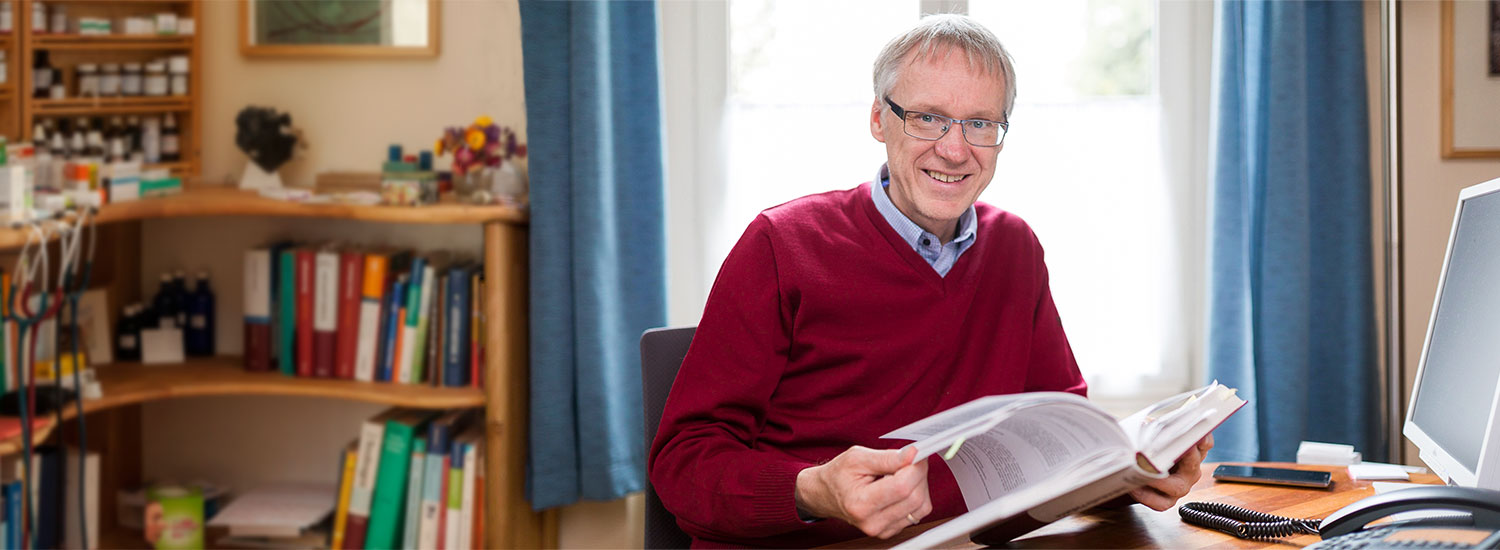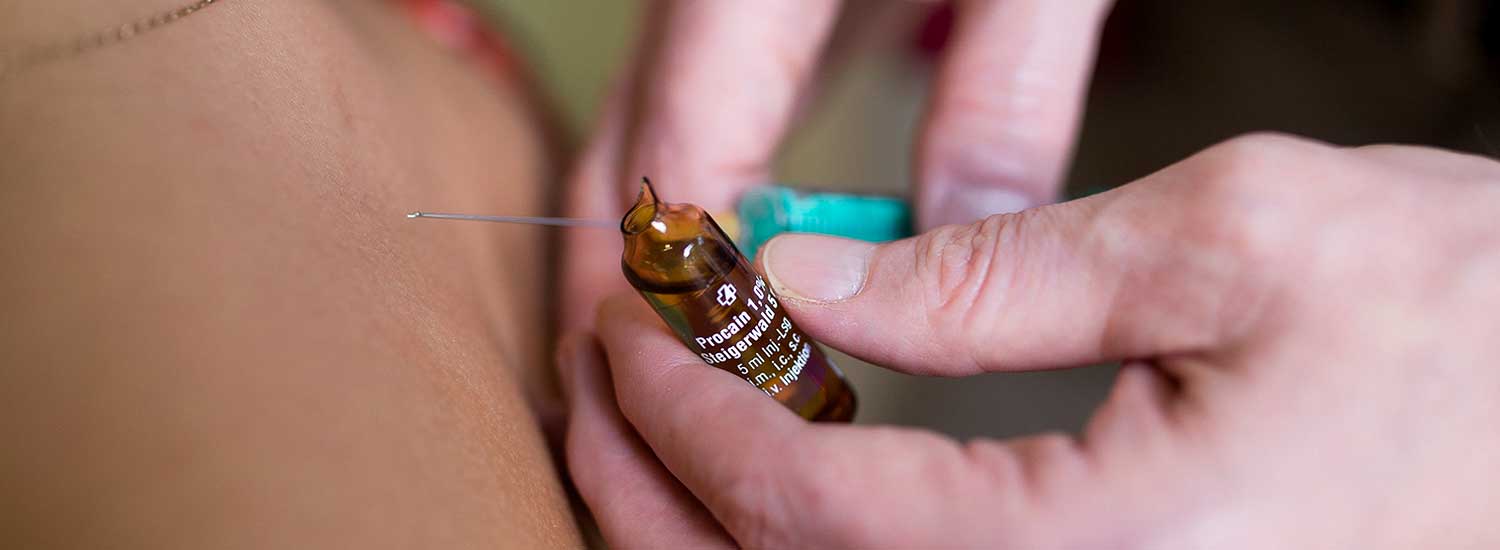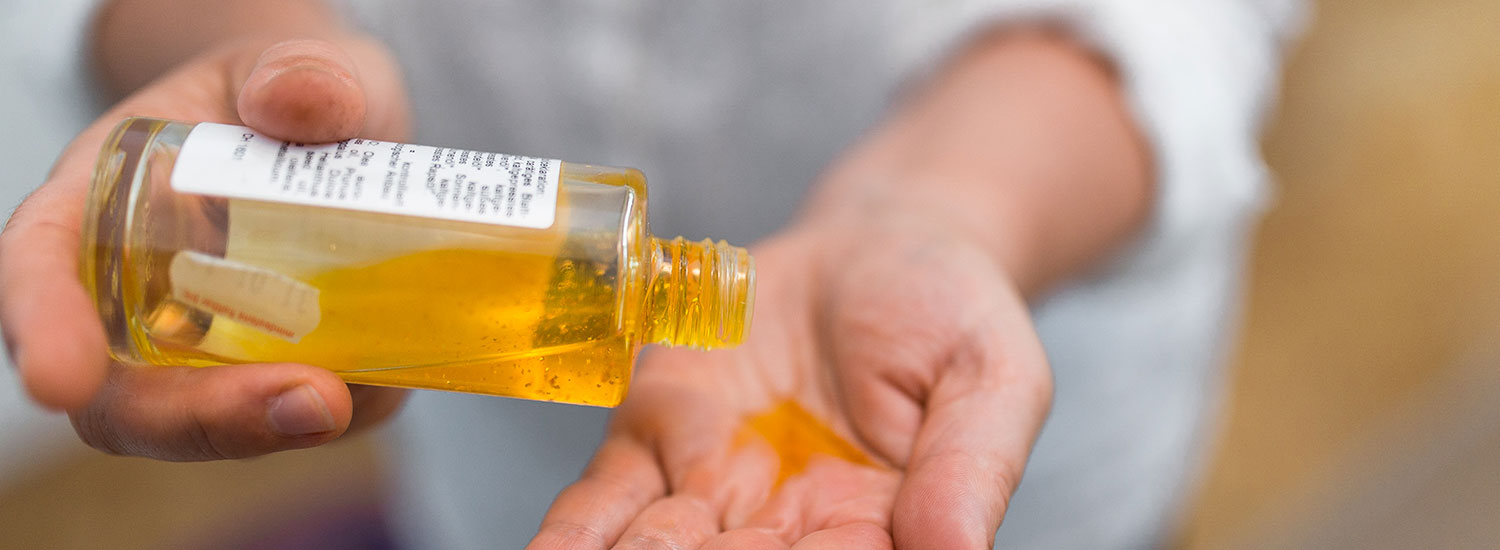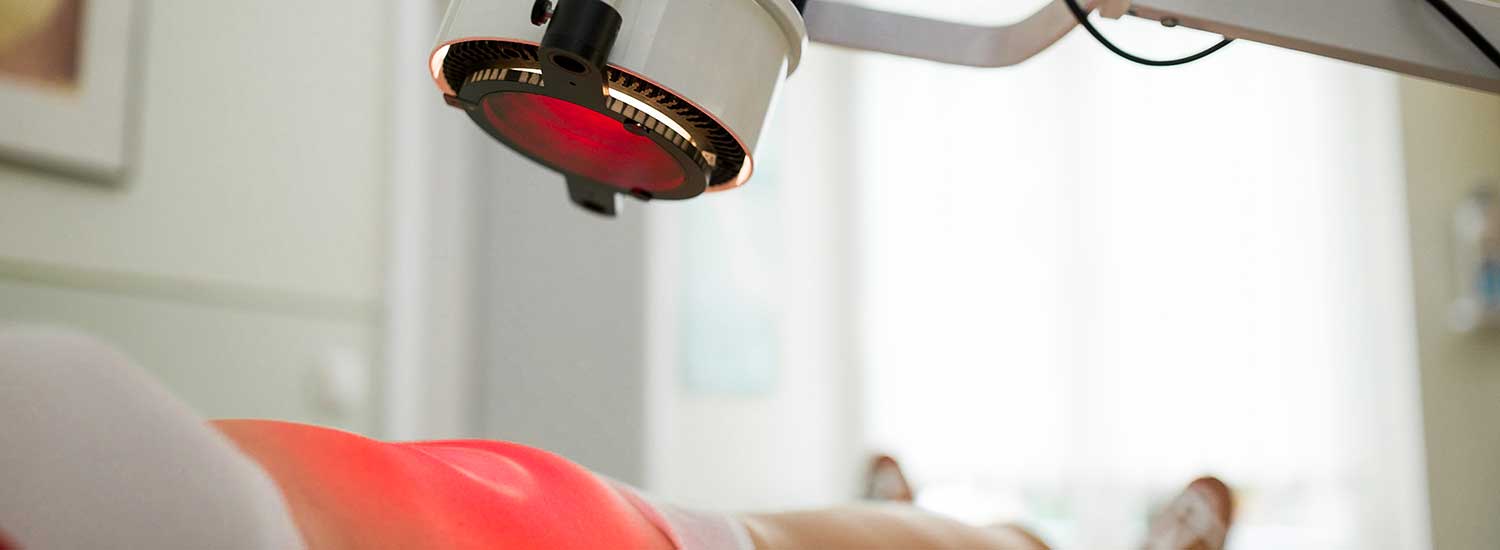Naturopathic medicine offers an impressive range of effective measures and therapies to treat disease. As different as these may be, they all pursue the same goal: to activate the body’s powers of self-healing.
In our practice, we offer the following:
- Heat, light and colour therapy (Hydrosun)
- Heart rate variability (HRV)
- Plant-based therapies (phytotherapie)
- Neural therapy (according to Huneke)
- Chronic inflammation – specialised treatments
- Deacidification, pain & regulatory therapies
HYDROSUN® – heat, light and colour therapy
Sunlight is the original source of all life. Localised colour and heat therapy is a modern procedure free of any side effects that follows the model of the sun in using infrared rays to actively stimulate blood circulation to the body’s tissues and thereby achieve a higher level of oxygen saturation. The deep warmth generated by the Hydrosun irradiator is particularly useful in pain relief. Furthermore, different colours can support the healing process.The advantages of Hydrosun® heat therapy Heat therapy is one of the oldest therapeutic practices. For the first time, the Hydrosun irradiator provides a deep-acting form of warming radiation that does not burn, irritate or dry out the surface of the skin. In contrast to conventional infrared radiators, this special medical device reproduces the filtering effect of the earth’s atmosphere on the solar rays. Modelled on natural sunlight, Hydrosun devices produce radiation in the infrared range without harmful UV radiation. The water-filtered infrared A-radiation acts on the deep layers of human tissue. The healing power of colour The healing power of light and colour has been known for thousands of years. Today, therapists are rediscovering these restorative effects and recording some amazing success stories. It has become clear that each colour has its own unique effect on our body, mind and energetic system. Even if scientists have so far been unable to pinpoint the underlying mechanisms (similar to homeopathy or acupuncture), the effects of blue and red light have already been empirically confirmed. In modern treatments, for example, blue light is used in neonatal clinics to irradiate newborns suffering from jaundice while red light is a core element of thermotherapy. Meanwhile, the integrating power of colour is being applied in many therapeutic contexts, including kinesiology, traditional Chinese medicine, Feng Shui or relaxation therapies.
Heart rate variability (HRV)
The measurement of heart rate variability is a modern diagnostic tool deployed to analyse the microscopic time-signals of the heart. These tell us something about our biorhythm, our stress levels, our general stamina and physical fitness as well as giving an indication of cardiac arrhythmia or diseases of the autonomic-vegetative nervous system.Parasympathetic and sympathetic nervous system Every human being has a vegetative nervous system that controls all unconscious processes in the body – including our heart rate, breathing or sleep patterns. Alongside the central nervous system (CNS), which steers the movement of our fingers, for example, the vegetative nervous system is completely independent. When we are stressed, the sympathetic response (the so-called “fight or flight response”) is dominant. This gives way to the parasympathetic response when we are sleeping or recovering from the excitement of having escaped the lion’s jaws. If we suffer from chronic stress, the parasympathetic nervous system becomes inhibited and we are unable to recover properly. If this overload continues for longer periods, the activity of the sympathetic nervous system also becomes weaker: our energy levels drop and we are in danger of succumbing to burnout. Understanding the signals of the heart This danger can be discerned from the variability of our heart rate, which we also call the spontaneous variation of the rhythm of the heart. This is because our heart normally never beats with complete regularity. If the sympathetic nervous system is increasingly dominant, the intervals between the individual heartbeats become more uniform over time; but if the parasympathetic nervous system is dominant, the times between the individual heartbeats vary. We make use of these aspects of variability in heartbeat to test the heart’s ability to adapt to different situations: The less your heart beats in a fixed, steady state, the higher the HRV oscillates and the easier it is for the body to shift up or down a few gears quickly. An irregular, sinusoidal, accelerating and decelerating heartbeat is a sign that your basic vegetative-autonomous function is normal and healthy. On the other hand, an inflexible rhythm indicates that something is wrong. Low HRV can be a symptom of stress or excess sport: your heart will beat more evenly in the hours and even days after intense physical and mental stress. Unfortunately, many patients suffering from burnout are unaware of their condition. By investigating the HRV, we can determine within thirty minutes the state of your autonomic nervous system. If your values prove unsatisfactory, we can consider together ways to return your heart to a healthy level of variability.
Plant-based therapies (phytotherapie)
Plant-based medicines are a well-tolerated alternative and versatile supplement to conventional, chemically-derived treatments. Unfortunately, their effects are still often generally underestimated. Herbal therapy can often be used to treat mild, chronic or psychosomatic illnesses as well as functional disorders. Active substances derived from medicinal plants (plant extracts, in particular so-called whole plant extracts) support the body’s powers of self-healing and have fewer side effects than conventional treatments. Recent research findings indicate that the human organism can be profoundly changed through the genetically-based properties of plants and their various modes of action.Ancient knowledge of the healing power of plants The earliest recorded usage of medicinal plants dates back 6,000 years. In Ancient Greece, the founder of Western medicine, Hippocrates, wrote extensively about herbal remedies, while in the Middle Ages this work was continued by monks and nuns such as Hildegard of Bingen (1098-1179). Paralcelsus (1493-1541) published the medical theories of the ancient Egyptians, who deduced the healing properties of a plant from its appearance, a hypothesis which has been partly confirmed by modern research: a tea made from lungwort, for example, whose spotted leaves reminded Paracelsus of lung tissue, is used to help relieve chronic respiratory disease. Today, modern medicine has largely forgotten this ancient knowledge – an unfortunate state of affairs that can be attributed to factors such as the witch-hunts of female and male herbalists, the far-reaching repercussions of Enlightenment philosophy and later, of course, the rise of modern pharmaceuticals, often referred to as the “triumph of chemistry”. In contrast, Chinese or Indian-Ayurvedic medicine has preserved ancient knowledge of the healing powers of plants, ensuring that traditional herbal medicine is until today viewed as a standard form of treatment. How does herbal therapy work? Herbal medicines can be used to stimulate and support the normal functioning of internal organs (or systems of organs) and thus detoxify the body. As each plant has its own individual healing power, the effects of which will depend on the particular mix of substances, herbal therapy can be applied in diverse ways. The active components are usually complex combinations of essential oils, bitter substances, tannins, minerals, trace elements or vitamins. In principle, whole plants or parts thereof (e.g. the blossoms, leaves, roots, bark, fruit, seeds) are processed into herbal juices or tinctures, extracts, essential oils, ointments, powders, drops or lozenges. The most common use of medicinal plants is as a tea, whether hot or cold-water infusion or decoction.
Neural therapy (according to Huneke)
Neural therapy is a holistic and regulatory treatment. In a healthy body, the body’s own regulatory system acts to control the constant interaction of all organs, muscles, nerves, connective tissue and skin, much like a conductor leading an orchestra. While we can compensate for minor functional disorders, if the number of minor disorders increases, this can cause disharmony in the body’s own orchestra, which then becomes noticeable through pain or illness. Sometimes these pathological changes, which accumulate into so-called interference fields, are “silent”, i.e. they do initially cause any obvious problems to the patient. Using the techniques of neural therapy, we can, firstly, detect such interference fields and, secondly, restore the body’s healthy internal rhythm. In this way we are able to relieve pain and heal disease.How does Neural Therapy work in the body? Its effect can be explained quite well by considering the normal continuous flux of energy within a healthy organism. If this flow is interrupted by so-called “interference fields”– such as chronic inflammation, scars, slowly healing wounds, damaged teeth or ulcerative processes – this creates an energy blockage, which, in turn, leads to pain or illness, even at locations far from the original problem. Thus, under unfavourable circumstances, an ulcerated but “silent” tooth can cause life-threatening disturbances to the heart’s normal rhythm. By temporarily shutting down an interference field, we are able to restore the flow of energy. This can be achieved, for example, by injecting nerve-deadening substances into a painful joint where there are irritating scars. For this we use local anaesthetics at very low concentrations (e.g. 1% procaine solution) or homeopathic and other biological medicines. The treatment can give rise to the “phenomenon of seconds”, as discovered by Ferdinand Huneke in 1925 when he accidentally gave his sister an injection of the anaesthetic procaine, leading to the sudden and permanent disappearance of her migraine. While treating other patients, he found out together with other colleagues that it was not the anaesthetic effect of the drug that had led to this beneficial effect but rather the irritation caused by the injection. This triggers the body’s own regulatory mechanisms, for example, to neutralize the excessive acidity in the tissue and improve circulation, thereby boosting the exchange of oxygen (respiration) in the body’s cells. The healing effect is, therefore, due less to the direct anaesthetic effect than the temporary disabling of the interference fields, thereby giving the body the chance to normalise the disturbed regulatory processes and restore these to a healthy rhythm. Which disorders can be helped by Neural Therapy? Neural Therapy can be used to treat almost all forms of acute pain or inflammatory conditions as well as chronic illnesses for which interference fields are suspected to be the primary cause. For example: ■ disorders of the musculoskeletal system ■ rheumatic disorders ■ headaches ■ vegetative disorders ■ high blood pressure ■ urological diseases or ■ gynaecological complaints (menstrual disorders, fertility problems, chronic irritation of the bladder, pre- and post-menstrual syndromes). ■ cancer patients usually experience pain relief. Neural Therapy has no undesirable side effects if the treatment is applied under expert supervision and care. However, as with all treatments that aim to trigger a reaction in the organism, there may be a temporary worsening of the condition or the psychological reappearance of hidden traumas experienced by the body.
Chronic inflammation – specialised treatments
When we speak of inflammation, most people think of redness or swelling. These symptoms are easy to recognise and usually straightforward to treat. However, more and more of us are being affected by inflammation of a completely different kind, one which, if left untreated, can spread throughout the body and cause major disease such as autoimmune disorders or cancer.What lies behind chronic inflammation? Initially, inflammation cannot be considered a disease. It merely indicates that the body has initiated a defensive immune reaction and that the healing process is in full swing. Basically, the term “in-flammation” implies that a “fire” has been ignited in the form of great heat – a so-called cytokine storm – which is intended to burn off “foreign” or harmful germs and bring about a deep cleansing. If this succeeds, the body emerges strengthened by the crisis. However, if the immune system is weakened or the salutary inflammatory processes are unsuccessful for other reasons, the harmful germs cannot be completely eliminated from the body. While the original symptoms and pain may become weaker, any ongoing inflammatory process can turn into chronic inflammation within only a few weeks. The longer this lasts, the greater the acidification of the body’s tissues. The body’s immune defence becomes weaker and the level of cell damage increases. Some examples are frequent recurring inflammation of: ■ the tonsils, ■ the nasal mucosa, ■ the conjunctiva (lining of the eyes), ■ the bronchial mucosa, ■ the gums ■ the skin and intestinal mucosa (expressed as allergy, atopic dermatitis, neurodermatitis, psoriasis, chronic inflammatory bowel disease). Inflammation associated with pus will frequently become chronic. Autoimmune diseases are also characterised by a chronic inflammatory reaction of the internal organs. In some cases, a continuously inflamed stomach lining can become cancerous. How do autoimmune diseases affect the body? If the immune system attacks and destroys the body’s own tissue, this leads to a recurring cycle of inflammation, which can severely damage the affected organ. The most common autoimmune diseases are Crohn’s disease (chronic inflammation of the bowel), multiple sclerosis, Hashimoto’s thyroiditis (chronic inflammation of the thyroid gland), polyarthritis (rheumatism or chronic inflammation of the joints), chronic borreliosis (neuroborreliosis) or type 1 diabetes. How can we treat chronic inflammation? For a therapy to be successful, it is vital to break the cycle of frustrated immunological defence caused by germs. In our practice, we primarily achieve this through therapies to modulate the immune response: For example, by means of: ■ mistletoe therapy, ■ fever-reducing treatments, ■ infusions, ■ the administration of plant extracts, ■ vitamins and ■ trace elements. In the case of chronic inflammation, anthroposophic medicine can help the immune system break free of the cycle of inflammation and restore the balance of the entire organism by strengthening the etheric forces, by uncovering mental disturbances and by stabilising the psyche.
Deacidification, pain & regulatory therapies
Do you often feel listless, tired, exhausted or nervous? Are you prone to infections? Do you have odd aches and pains? Or are you suffering from chronic pain, age-related joint problems, rheumatism, osteoporosis or cancer? In such cases, your body is possibly afflicted by excess acidity. A disturbed pH balance can lie behind a wide range of diseases as well as pain and metabolic disorders (obesity). And the trend is rising. This is the reason why many therapies are unsuccessful – because the basis for any physical improvement is a healthy cell metabolism.The most common causes of a disturbed pH balance (acid-base balance) are: ■ a faulty diet (i.e. one rich in protein and carbohydrates or with excessive consumption of meat, wheat products, milk and soya products, alcohol, coffee, sugar), ■ chronic inflammation, ■ chronic pain, ■ an unhealthy lifestyle (too much stress, a lack of exercise), ■ environmental toxins. How can excess acidity be detected? ■ by measuring the pH of saliva or urine samples, ■ by measuring the acid-base buffer capacity in the blood according to Jörgensen, ■ by conducting a microbiological analysis of the human “biome” in a special laboratory. Which treatments are available? There are several ways to provide physical relief and enhance the body’s self-healing powers. The first step towards improvement can be to simply restore the internal regulatory mechanisms. In many cases, this will ensure the success of every additional therapy. We therefore advise our patients to adopt a well-balanced basal diet, if necessary supported by therapeutic fasting and alkaline powders or tablets. In addition, it is important to relieve stress and reduce any harmful environmental impacts. a) When is it recommended to apply a procaine base infusion? If the previously mentioned measures for pH regulation prove insufficient or if the bicarbonates contained in the base therapies are not well tolerated, we recommend treatment with a procaine base infusion. Application of procaine for improved pH regulation together with sodium bicarbonate (the primary alkali for medical treatment) can quickly deacidify or detoxify the body’s tissues. This can boost blood circulation to undersupplied, chronically painful or inflamed areas. The therapy relieves pain and helps relax the body. It enhances the effect of other immune-boosting therapies and protects the liver and pancreas. Procaine dilates the blood vessels, even the finest capillaries; further, it has an anti-rheumatic and antioxidant effect, lowers fat levels in the blood and functions to balance the autonomic nervous system. We thus recommend detoxification and deacidification therapy for most chronic diseases, to relieve pain, for rheumatism, arthritic problems and chronic skin complaints, to boost physical vitality as well as a supplement to biological cancer therapy. b) In addition to their deployment in cancer treatment, high-dose infusions of vitamin C can help reduce acidosis. Depending on the indication, we apply a range of doses, i.e. 7.5g - 15g - 25g - 30g - 50g. Experience shows that a course of 10 infusions (up to three per week) are ideal, though in some cases only one infusion per week is sufficient. This treatment can be alternated with procaine base infusions (see a)!







